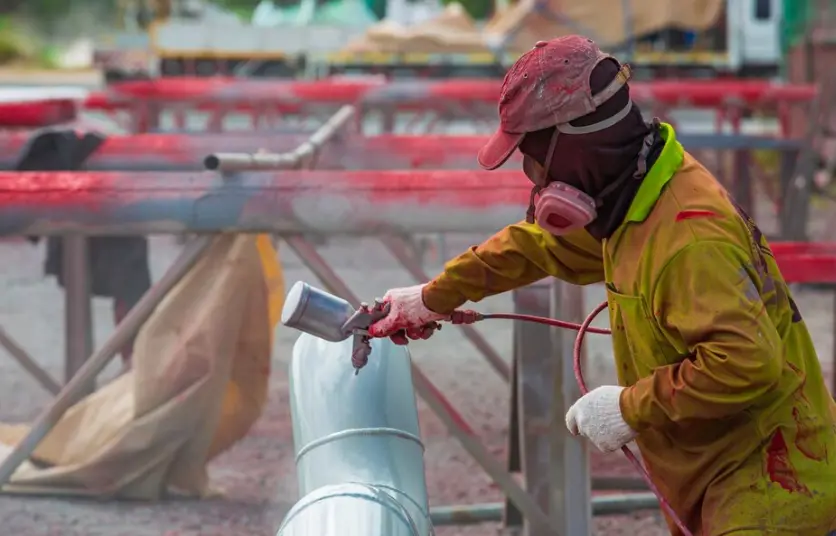
Understanding Dye Penetrant Inspection
Dye Penetrant Inspection (DPI), also known as Liquid Penetrant Testing (LPT), is a critical non-destructive testing (NDT) method used to identify surface-level flaws in solid, non-porous materials. This testing method plays a pivotal role in industries that demand absolute material integrity, such as the pressure vessel, aerospace, and petrochemical sectors.
Comparison to Other NDT Methods
Unlike Ultrasonic Testing (UT) or Magnetic Particle Testing (MT), DPI is simple, portable, and doesn’t require power-intensive equipment. While UT can detect both surface and subsurface flaws, it requires specialized training and is more complex. MT is limited to ferromagnetic materials, whereas DPI is effective on a wide variety of non-porous materials, including stainless steel, aluminum, and certain plastics.
How DPI Works
How Dye Penetrant Inspection Detects Surface Cracks
Types of Defects Identified
Common defects DPI can detect include:
- Fatigue cracks from repeated stress cycles
- Porosity, such as pinholes in welds
- Seams or laps caused during manufacturing
- Lack of fusion in weld joints
These defects compromise the strength and performance of components, especially in high-pressure applications.
How DPI Works on Non-Porous Materials
Benefits of Dye Penetrant Inspection
- Cost-effective: Requires minimal equipment
- Portable: Ideal for on-site or field inspections
- Easy to perform: Does not require extensive training
- Quick turnaround: Visual results are often available within an hour
These advantages make DPI an accessible and reliable method for quality assurance.
Step-by-Step DPI Procedure
1. Surface Preparation
Proper cleaning is essential. The test surface must be:
- Free of oil, grease, paint, or rust
- Dry and smooth, ensuring no absorbent contamination
Solvents, abrasive pads, or ultrasonic cleaners may be used depending on the material.
2. Penetrant Application and Dwell Time
The penetrant is applied evenly across the surface. Depending on the material and environmental factors, the dwell time ranges from 5 to 30 minutes. Longer dwell times may be required in colder temperatures or for tighter cracks.
3. Excess Penetrant Removal
Once the penetrant has dwelled, any excess must be removed without disturbing the penetrant trapped in flaws. The cleaning method depends on the type of dye:
- Water-washable penetrants: Removed with a gentle water spray
- Solvent-removable penetrants: Cleaned using lint-free wipes and solvents
- Post-emulsifiable penetrants: Require a separate emulsifier step
4. Developer Application and Flaw Detection
The developer, typically a white powder or water-based suspension, is applied evenly. It draws penetrant out of flaws, making indications visible. Inspectors then examine the surface:
- Visible dyes require bright white light
- Fluorescent dyes need UV (black) light in a dark environment
5. Interpretation and Documentation
Once indications are visible, they are:
- Classified by type and severity
- Compared to acceptance standards (e.g., ASME Section V or ASTM E1417)
- Documented for traceability and compliance
Clear records of inspection conditions, results, and technician credentials are essential for audits and future evaluations.
Industry Standards and Personnel Qualifications
Relevant Codes and Standards
Red River and other reputable manufacturers perform DPI in compliance with major industry standards:
- ASME Section V: Governs NDT for pressure vessel fabrication
- ASTM E1417: Outlines best practices for liquid penetrant testing
- API 510: Applies to in-service pressure vessel inspections
Certification Requirements
Qualified personnel are vital for credible results. Inspectors must be certified under:
- SNT-TC-1A by ASNT (U.S. standard)
- ISO 9712 (internationally recognized)
Technicians must demonstrate both theoretical knowledge and practical proficiency.
Red River’s Commitment to Quality
At Red River, DPI is carried out by trained and certified professionals following documented procedures. We ensure full traceability, data integrity, and compliance across every project.
Why Dye Penetrant Inspection Matters
Dye Penetrant Inspection remains a cornerstone of surface-level quality control in fabrication. Its simplicity, sensitivity, and affordability make it a preferred method for early detection of critical surface defects. By identifying flaws before they become failures, DPI plays a crucial role in ensuring safety, reliability, and compliance in pressure vessel manufacturing and beyond.
In conclusion, in safety-critical applications, DPI continues to support manufacturers in delivering code-compliant, high-integrity products that meet the demands of today’s industrial landscape.
Need a reliable partner?
Red River specializes in the design and manufacturing of pressure vessels. We also fabricate related items such as prefabricated spools and skid packages.
Reach out to us today and experience the Red River difference. Where American-made products and American Values come together, we care more.
Frequently Asked Questions
1. What materials can be inspected using dye penetrant inspection?
DPI is effective on smooth, non-porous materials like metals, ceramics, and some plastics.
2. Can DPI detect internal defects or only surface flaws?
DPI only detects surface-breaking defects. Subsurface flaws require UT or RT methods.
3, How long does a typical DPI process take?
It depends on part size and dwell time, but most inspections are completed in 30 to 60 minutes.
4. What is the difference between visible and fluorescent penetrants?
Visible dyes are easy to use under white light; fluorescent dyes offer higher sensitivity and require UV light.
5. Is DPI safe for use in the field?
Yes. It is generally safe when using proper ventilation, gloves, and disposing of chemicals responsibly.
6. Can dye penetrant inspection be automated?
Yes. DPI can be automated for high-volume or repetitive parts, improving consistency and efficiency.
7. What are common applications of DPI in pressure vessel fabrication?
DPI is used to inspect welds, flanges, nozzles, and repair zones in both shop and field settings.
8. What certifications are required for DPI technicians?
Technicians should be certified under SNT-TC-1A or ISO 9712, depending on jurisdiction and client requirements.
Key Takeaways
- Dye penetrant inspection is a practical and reliable method for detecting surface-breaking flaws in welds and components.
- It is portable, economical, and easy to apply, especially in pressure vessel and field environments.
- DPI is not suitable for internal defect detection but remains a valuable first line of defense for surface integrity.
- Following established codes and standards ensures reliable, repeatable results.
- Qualified technicians and detailed documentation are essential for meaningful inspections and code compliance.
